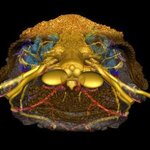Evolution

Humans didn't cause problems for everything we get blamed for but DNA evidence in a paper suggests that the ancient New Zealand megaherbivore, moa, a distant relative of the Australian Emu, did go extinct shortly after Polynesians arrived in the late 1200s.
All nine species of New Zealand moa, the largest weighing up to 250 kilograms, have been gone for centuries and other studies suggest that huge populations of moa had collapsed before people arrived and hence influences other than people were responsible for the extinction, like climate change killing the vegetation. Instead,…

Researchers have found the earliest fossil evidence for the presence of bone marrow in the fin of a 370 million-year-old fish,
Eusthenopteron, a Devonian lobe-finned fish from Miguasha in Canada that is closely related to the first tetrapods.
Long bones, which are found in the limb of tetrapods, are not only important for locomotion and supporting the weight of the body, but also host the bone marrow. The latter plays a major role in hematopoiesis, i.e. the formation of blood cells. In a healthy adult human, about a hundred billion to one trillion new blood cells are produced every day to…

A new study finds that sea anemones display a genomic landscape with a complexity of regulatory elements similar to that of fruit flies or other animal model systems, which suggests that this principle of gene regulation is already 600 million years old and dates back to the common ancestor of human, fly and sea anemone.
But sea anemones are more similar to plants rather to vertebrates or insects in their regulation of gene expression by short regulatory RNAs called microRNAs.
Our appearance, the shape we have and how our body works is, in addition to environmental influences,…

Cell metabolism is a crucial biological function for all living organisms but understanding how life may have emerged is difficult. And learning some answers may make it possible to learn whether it is possible for life to have emerged in similar environments on other worlds.
Researchers writing in Astrobiology
detail their new approach to simulating the energetic processes that may have led to the emergence of cell metabolism.
Dr. Terry Kee from the School of Chemistry at the University of Leeds, one of the co-authors of the research paper, said, "What we are trying to do is…

Evolutionary biologists have long considered bird song to be an exclusively male trait, resulting from sexual selection. A new paper says that's not the whole story.
The results of their analysis, now published in Nature Communications, showed that the common ancestor of modern songbirds had female song.
It doesn't turn Darwin's theory of sexual selection on its head, but it does mean there is more to the story than what Darwin proposed. Sexual selection has played a major role in the evolution of elaborate bird song but other selection pressures or processes have also probably played a role…

The first life developed in ancient oceans some 3.6 billion years ago, but then nothing much happened. For a billion years, we remained pretty much a layer of slime.
Then 550 million years ago, evolution came roaring back and here we are today. So what was the hold-up during a billion boring years?
According to University of Tasmania geologist Professor Ross Large and colleagues, the key was a lack of oxygen and nutrient elements, which placed evolution in a precarious position. "During that billion years, oxygen levels declined and the oceans were losing the ingredients needed for life…

A mouse's heart beats about the same number of times in its lifetime as an elephant's, but a mouse only lives for about a year while an elephant will live to be about 70.
Why do small plants and animals mature faster than large ones? Why has nature chosen such radically different forms as the loose-limbed beauty of a flowering tree and the fearful symmetry of a tiger?
It's more than metaphysics. An interdisciplinary team of researchers from the University of Maryland and the University of Padua propose the answer to this evolutionary question is based on Kleiber's Law, a famous…

How did we evolve a face?
Vertebrates, backboned animals, come in two basic models: jawless and jawed. Jawed vertebrates, including us, number over 50,000 species but there are two jawless vertebrates in existence today; lampreys and hagfishes. It is known that jawed vertebrates evolved from jawless ones, a dramatic anatomical transformation that effectively turned the face inside out.
A team of researchers used micron resolution X-ray imaging and show how a series of fossils, with a 410 million year old armored fish called Romundina at its center, documents the step-by-step…

Evolutionary biology sounds exciting - there wouldn't be any movies on the SyFy Channel without Gatoroids and Sharknados and other feats of life science run amok - but in reality you are going to spend a lot of time paying your dues watching sponges in mid-sneeze before you get to create an epidemic or a giant monster.
Sneezing sponges? Isn't that a little far-fetched, even for the network that brought us "Arachnoquake"? No, actually the sponge thing is real, and a new paper points to Porifera sneezing as evidence for a sensory organ in one of the most basic multicellular organisms on Earth,…

Backboned animals, at least the ones with jaws, have four fins or limbs, one pair in front and one pair behind.
Thanks to that random prankster known as evolution, these have been modified into a marvelous variety of fins, legs, arms, flippers, and wings. But how did our earliest ancestors settle into such a consistent arrangement of two pairs of appendages?
It's because we have a belly say theoretical biologists (yes, that's a real thing) at the University of Vienna and the Konrad Lorenz Institute for Evolution and Cognition Research.
Numerous ideas have been proposed to…